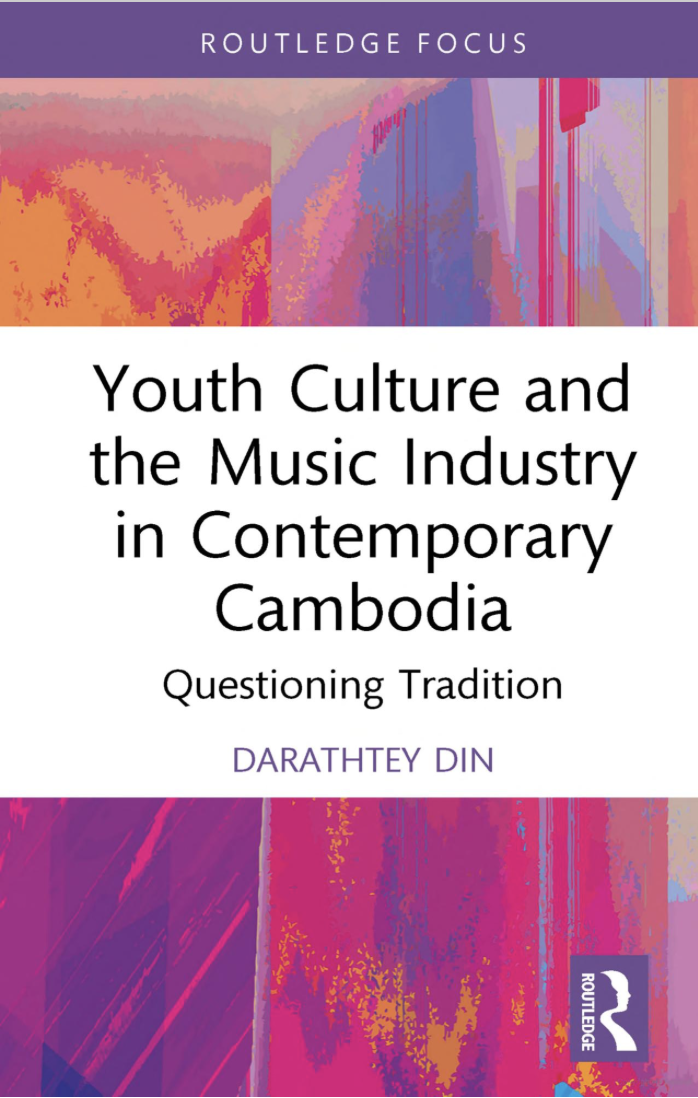Darathtey Din is a communications specialist, an independent researcher, and a cultural enthusiast. Her research interests include Cambodian identity and cultural legacy, and she also publishes a fortnightly newsletter called Campuccino covering diverse aspects of Cambodian politics, economics, arts, and culture. Recently she covered “Youth Culture and the Music Industry in Contemporary Cambodia” in a book for Routledge.

1. What inspired you to write about youth culture and the music industry in contemporary Cambodia?
My interest in researching youth, culture, music industry, and contemporary Cambodia came separately. Let’s start with the easy one first. I’m interested in writing about contemporary Cambodia because I think, as a country, we spend way too much time and effort holding on to the past, the good and the bad, and not enough effort to understand and dissect what is happening right now. Regarding culture, it is an under-research topic by local researchers because it is considered not that important and intangible, in my opinion. Besides, I find the topic of culture fascinating and very important. Despite being such an abstract topic, culture weave through every aspect of our lives both consciously and sub-consciously. Then, we have youth. It is a common fact that despite being the majority of the population, the country is still under the leadership of mostly elderly men. Also, being a somewhat traditional and conservative society, youth’s perspectives and preferences on many aspects are often dismissed as, well, young and not that important. Therefore, I want to illustrate that young people do many, a lot. By listening to what young people said and understanding how they think, can greatly affect how a certain policy is made and eventually where this country is heading. And lastly, we have the music industry. To be honest, it wasn’t in my original plan to touch on the music industry because I knew nothing about it from a research standpoint. However, findings from focus group discussions that I conducted pointed to music. So, I let that lead my research.

2. How has the music industry in Cambodia evolved over the past decade, and what impact has it had on youth culture?
The music industry in Cambodia has improved so much in many aspects: artistry, originality, and timeliness. We came from copying others to copying less and producing more of our own. This, of course, effects how youth identify withy and relate to Cambodian music. The rise of hip hop also draw in the young crowd. In the book, I touched on the history of hip hop and how the genre serves as a platform to represent the underrepresented. In Cambodia, I think hip hop allows the younger generation to express unconventional or challenging topics and feelings such as depression, family pressure, stereotypes etc.
3. What are some of the key challenges faced by young musicians in Cambodia today?
Ambiguous National Policy for Culture formalized restriction on artists and their freedom to create; lack of copyright protection and understanding of intellectual property; underdeveloped arts education which leads to lack of audience development from the early stage for the arts.
4. Can you discuss the role of social media in shaping youth culture and the music industry in Cambodia?
Social media provides more avenues for youth to explore and engage with arts and cultural products not just from Cambodia but from all around the world. This means they have more freedom to consume and support cultural products that they identify with and relate to, especially music. This presents as a challenge for music industry in Cambodia because the industry is competing music from the West, K-pop, and even from neighboring country such as Thailand. However, social media helps bringing Cambodian musicians closer to their audience and vice versa. Operating in this creator economy, artists does not need to rely on big label to represent them in order to push out their work. Social media makes it easier to get their work to their audience and get to hear what their fans have to say about their music.
5. Are there any specific genres or styles of music that have gained popularity among Cambodian youth in recent years?
Hip hop. I touched on that already in Q2.
6. How do you see the relationship between traditional Cambodian music and the modern music scene among the youth?
I did not talk about traditional Cambodian music in my book. I did however look at the use of traditional music instrument in modern music scene. I think by incorporate traditional music instruments into contemporary music can create a new sound that is unique to Cambodia while at the same time preserving the presence and relevance of traditional music instruments.
7. What are some of the ways in which the music industry in Cambodia supports and promotes young talent?
I prefer to not answer this because I didn’t explore this in the book and don’t feel that I know enough to answer.
8. Have there been any notable collaborations between Cambodian musicians and international artists that have influenced youth culture?
The obvious one that came to my mind is Bong and Run This Town which were a collaborated product between VannDa and celebrated Thai rap artists. It produced a sound unique to the region. So, going forward, this can helps not just represent Cambodia’s hip hop scene but Southeast Asia’s evolving hip hip scene to the world. This is also help presenting different perspective on the relationship between Cambodia and Thailand which is usually muddled with historical conflicts.
9. How does the music industry in Cambodia contribute to the overall cultural identity of the country?
With new works coming out in the past few years, the current music industry illustrates that there is more to Cambodia beyond temples and trauma. The younger generation has the artistic ability and imagination to push the boundaries of what it means to be Cambodia and how that looks like in their artistic work.
10. What are your predictions for the future of youth culture and the music industry in Cambodia?
I think Cambodian youth will continue to explore their roots and the meaning of their Cambodianness. They will also continue to challenge and change many traditional norms that are no longer relate to them or Cambodia in the modern day context. As for music industry, it will evolve to reflect how contemporary Cambodia is going to the push and pull motion between the olds and the news.
Editor’s Note:
To celebrate International Women’s Day, When in Phnom Penh hopes to feature a series of weekly interviews leading up to this special day. These interviews will highlight the diverse personalities and professional experiences of women, showcasing their unique contributions and stories. Through this initiative, we aim to provide a platform that elevates and amplifies the voices of women, recognizing their invaluable impact across various fields and walks of life.
